Memory Frequency Scaling on Intel's Skull Canyon NUC - An Investigation
by Ganesh T S on August 29, 2016 8:00 AM ESTPremium DRAM Options for the Skull Canyon NUC
There are plenty of DDR4 SODIMM kits that are compatible with the Intel Skull Canyon NUC (NUC6i7KYK). However, it is likely that people interested in memory overclocking are likely to go for the premium options in terms of speed as well as capacity. In addition to the frequency, the timing parameters / latency numbers also influence the performance. For our evaluation today, we are going to look at five different options (presented below in alphabetical order of the vendors):
- Corsair Vengeance DDR4 SODIMM 2x16GB @ 2666 MHz, 18-19-19-39
- Crucial Ballistix Sport LT DDR4 SODIMM 2x16GB @ 2400 MHz, 16-16-16-39
- G.Skill Ripjaws DDR4 SODIMM 2x16GB @ 3000 MHz, 16-18-18-43
- Kingston HyperX Impact DDR4 SODIMM 2x16GB @ 2400 MHz, 14-14-14-35
- Patriot Viper Series DDR4 SODIMM 2x16GB @ 2800 MHz, 18-18-18-43
Out of these kits, the G.Skill Ripjaws and the Kingston HyperX Impact stand out. The former for being the kit with the maximum rated operating frequency and the latter for having the lowest latency numbers of all the tested kits.
Corsair Vengeance [ 2666 MHz, 18-19-19-39 ]
The Corsair Vengeance memory kit used in our review supports XMP, and no special configuration is needed to take advantage of the higher performance timings. FinalWire's AIDA64 can do extensive parsing of the SPD information and present the results in an easy-to-understand manner. Our review kit contained memory sourced from Samsung.
CPU-Z shows the operating parameters of the SODIMMs as seen by the OS. AIDA64 also has a quick cache and memory benchmark that provides some basic bandwidth and latency numbers to ensure that the kits are operating as expected.
Crucial Ballistix Sport LT [ 2400 MHz, 16-16-16-39 ]
The Crucial Ballistix Sport LT memory kit also supports XMP, and was able to run at 2400 MHz right out of the box. Given that Crucial is Micron's brand, it is no surprise that the memory in the kit is sourced from Micron's fabs.
The relevant CPU-Z and AIDA64 memory benchmark screenshots are provided below.
G.Skill Ripjaws [ 3000 MHz, 16-18-18-43 ]
The G.Skill Ripjaws memory kit used in this study turns out to be an excellent candidate in terms of specifications. Not only does it operate at higher frequencies compared to all other kits in the review, it also has better latency numbers compared to the Corsair and Patriot kits which operate at lower frequencies. AIDA64 shows that the kit also supports two XMP profiles for the highest operating frequency (DDR4-3000), one at 16-18-18-43 and another at 18-18-18-43. The memory is sourced from Samsung.
Upon booting into the BIOS after installation, I found that the memory was only configured to run at 2667 MHz. Altering the 'Automatic' DRAM timings to 'Manual' and 'user-defining' the various timing parameters as printed on the SODIMM label (16-18-18-43) enabled higher frequency operation. I ran Memtest86 overnight to ensure that the NUC6i7KYK was stable with the manually input parameters before proceeding with the rest of the benchmarks.
Kingston HyperX Impact [ 2400 MHz, 14-14-14-35 ]
The Kingston HyperX Impact kit stands out for its low latency numbers / timing parameters. It also supports XMP, and the NUC6i7KYK booted with the kit operating at 2400 MHz right away. AIDA64 shows that the memory is sourced from SK Hynix's fabs.
The relevant CPU-Z and AIDA64 memory benchmark screenshots are provided below.
Patriot Viper Series [ 2800 MHz, 18-18-18-43 ]
The Patriot Viper series of DDR4 SODIMMs also supports XMP, and the kit worked at 2800 MHz right out of the box in the NUC6i7KYK. Even though the SPD information is incomplete, we confirmed from Patriot that the Viper series uses memory from Samsung's fabs.
The CPU-Z and AIDA64 benchmark numbers are reproduced below.


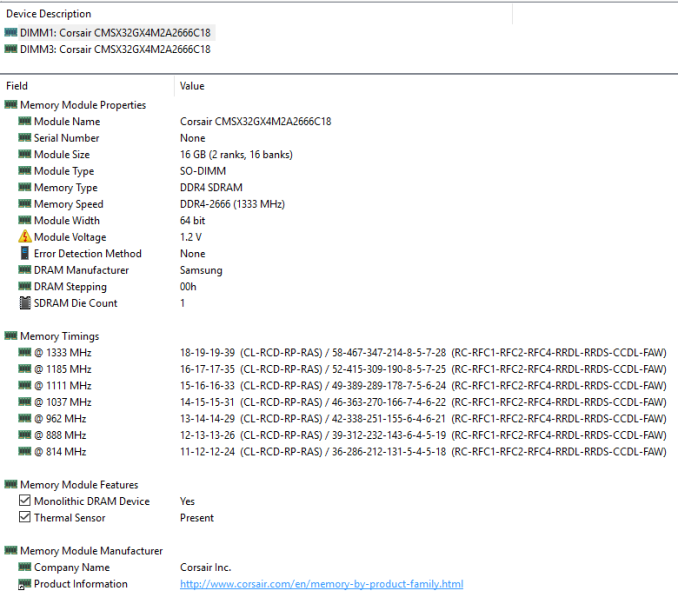
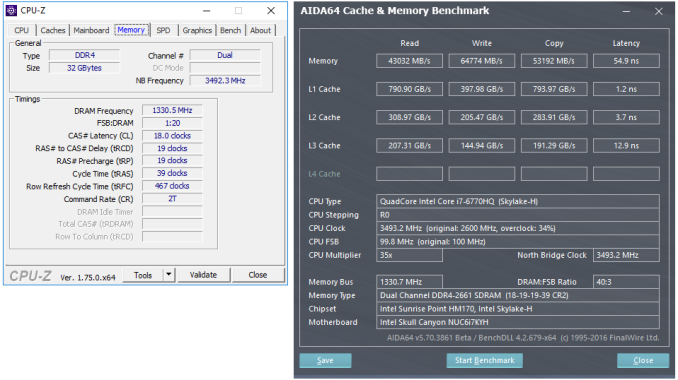

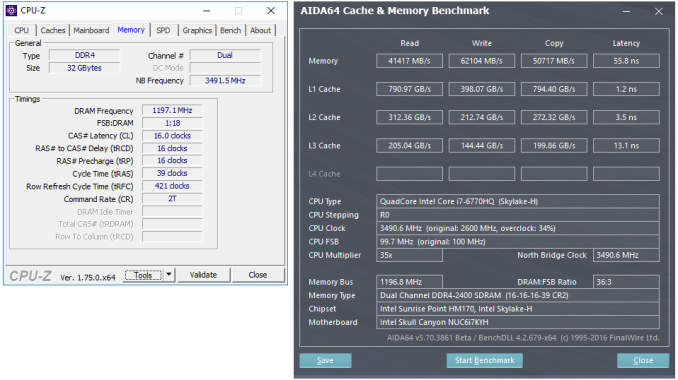
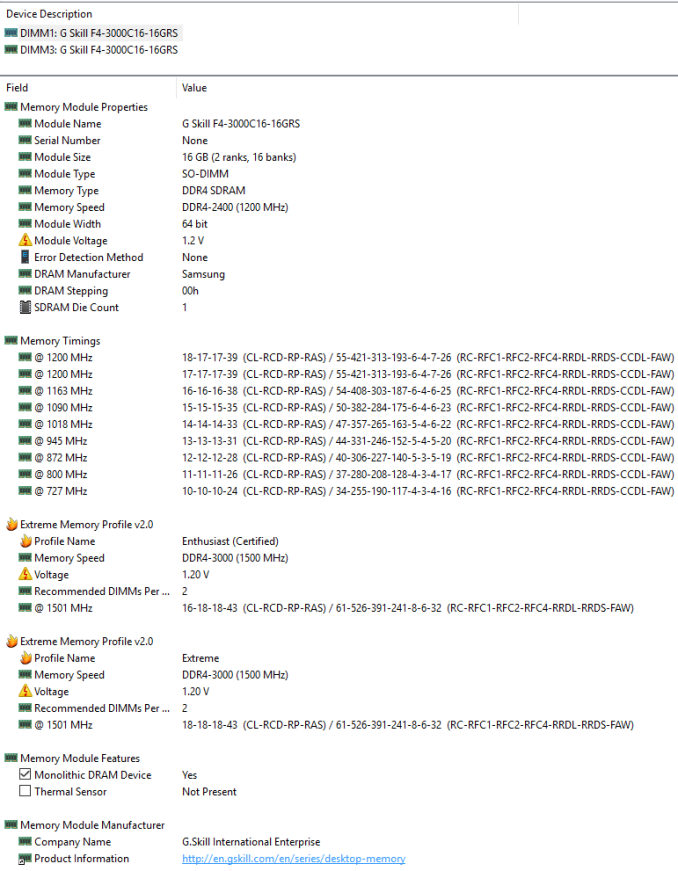
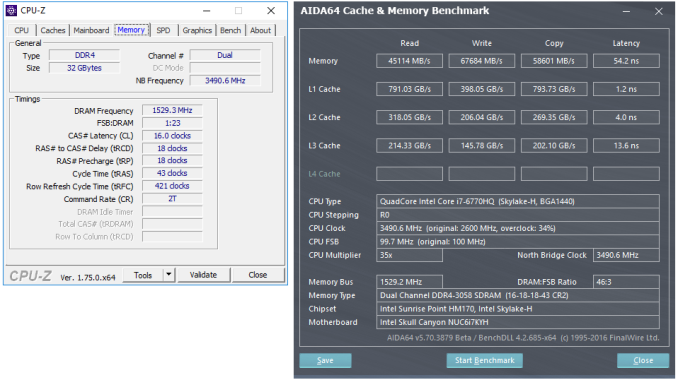
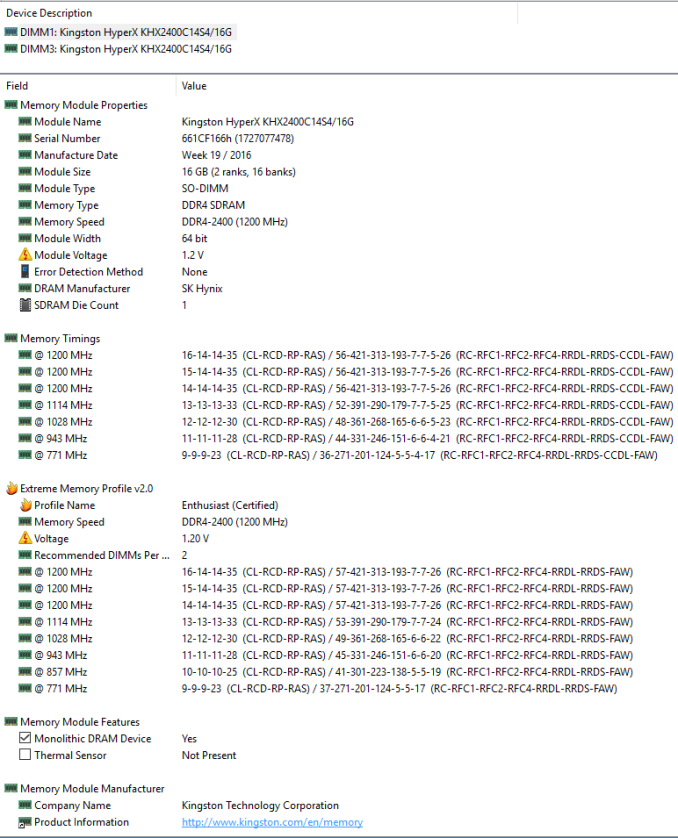
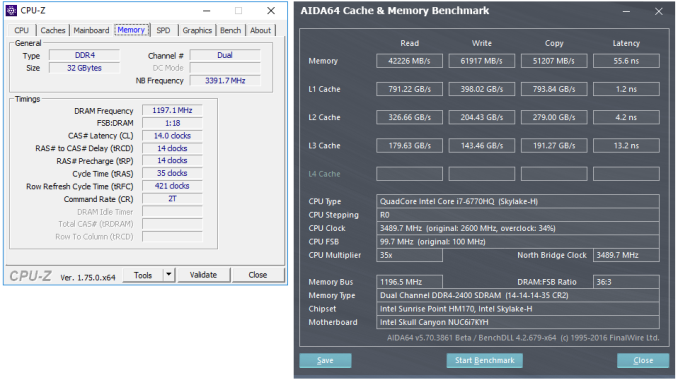
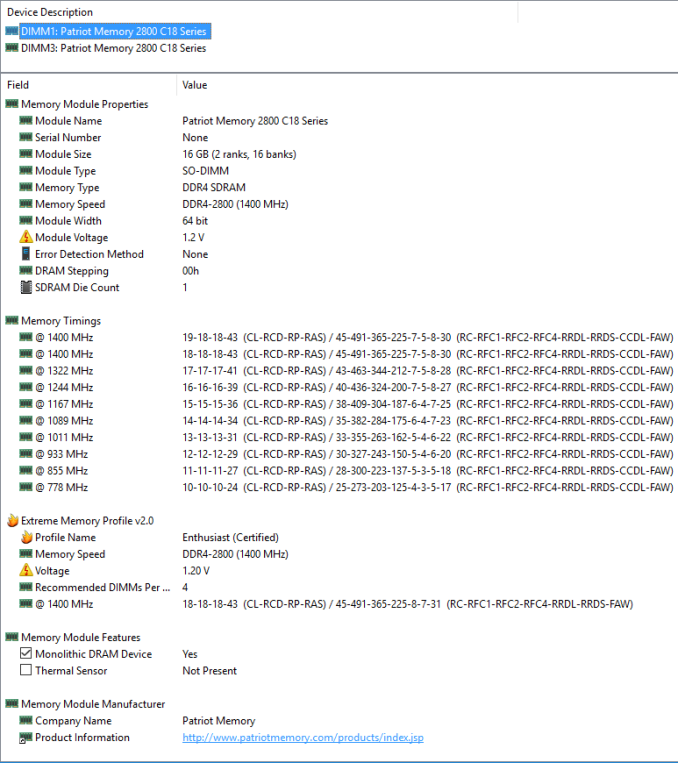
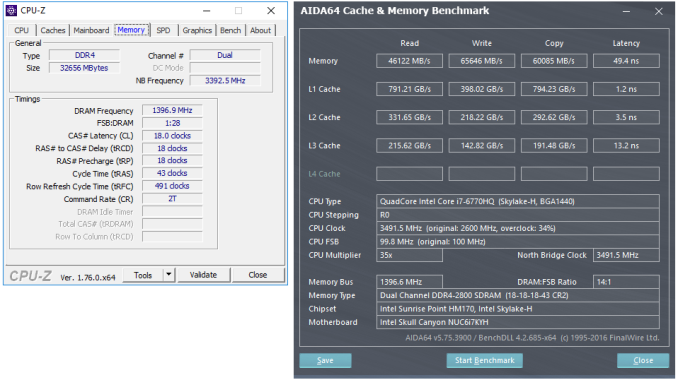








31 Comments
View All Comments
jjj - Monday, August 29, 2016 - link
The second graph on page 3 should be flipped upside down as lower latency is better and right now it is misleading if you aren't paying attention.snowmyr - Monday, August 29, 2016 - link
http://imgur.com/a/GxZWhYou're Welcome
kebo - Tuesday, August 30, 2016 - link
+1 internetsGigaplex - Monday, August 29, 2016 - link
"Upon booting into the BIOS after installation, I found that the memory was only configured to run at 2667 MHz. Altering the 'Automatic' DRAM timings to 'Manual' and 'user-defining' the various timing parameters as printed on the SODIMM label (16-18-18-43) enabled higher frequency operation."I'm not surprised. My G.Skill RAM (DDR3) also didn't perform as advertised in a plug and play fashion, and when I emailed to complain, they acted as if it was normal for manual entry to be required. So much for XMP compliance.
Ian Cutress - Monday, August 29, 2016 - link
The system BIOS automatically loads the SPD profile of the memory kit unless the XMP option is enabled. In most systems, XMP is disabled as the default option because kits without XMP (most of the base ones) don't exist. Also, the SPD profile is typically left as the base JEDEC settings to ensure full compatibility.If you want true plug and play of high speed memory kits, one of two things need to happen:
1) XMP is enabled by default (but not all memory will work)
2) Base SPD profiles on the memory should be the high-speed option (means the memory won't work in systems not geared for high performance)
There are a number of Kingston modules, typically DDR4-2400/2666, that will use option number (2). Some high-end motherboards have an onboard switch for (1). For everything else, it requires manually adjusting a setting in the BIOS.
The problem, as always, is maintaining wide compatibility. Just in case someone buys a high-end memory kit but wants to run it at base JEDEC specifications, because the hardware they are moving the kit into doesn't support the high frequency.
TheinsanegamerN - Monday, August 29, 2016 - link
dissapointing to see nearly no improvement in gaming benchmarks. You'd figure that a big iGPU would need more bandwidth with newer games.Perhaps current iGPUs just are not powerful enough. Maybe AMD will fix that with zen APUs next year.
Ian Cutress - Monday, August 29, 2016 - link
It's a function of the embedded DRAM. You would expect DRAM speed to affect the iGPU less when eDRAM is present because it provides a large 50GB/s bidirectional DRAM buffer. Without eDRAM, I would expect the differences in gaming results to be more. Will have to do testing to find out - this piece was focusing primarily on the Skull Canyon environment which lists high speed memory support as a benefit.Samus - Monday, August 29, 2016 - link
I haven't seen a memory frequency roundup like this since Sandy Bridge, which did show a slight benefit (more than Skylake for sure) moving from DDR3 1066 through 1333, 1600 and so on. Haswell I'm sure is a similar story. I had noticeable performance improvements on AM3+ platforms going from 1600 to 2400 especially in regard to the embedded GPU.With sky lake it seems you are just wasting your money to run potentially less reliable, more expensive memory out of specification. But I wonder if CPUs without the eDRAM have the same flat scale?
Ian Cutress - Monday, August 29, 2016 - link
Ivy Bridge: http://www.anandtech.com/show/6372/memory-performa...Haswell: http://www.anandtech.com/show/7364/memory-scaling-...
Samus - Monday, August 29, 2016 - link
Oh cool, thanks Ian! Should have figured you guys keep up with it.